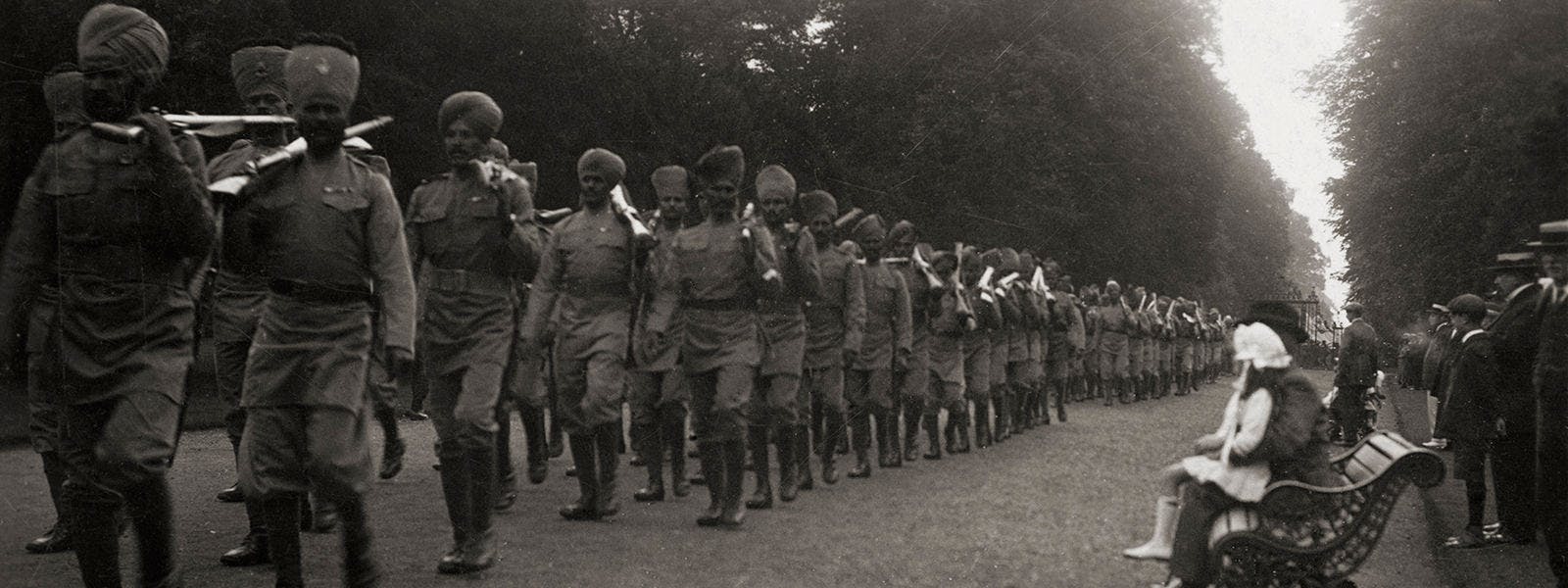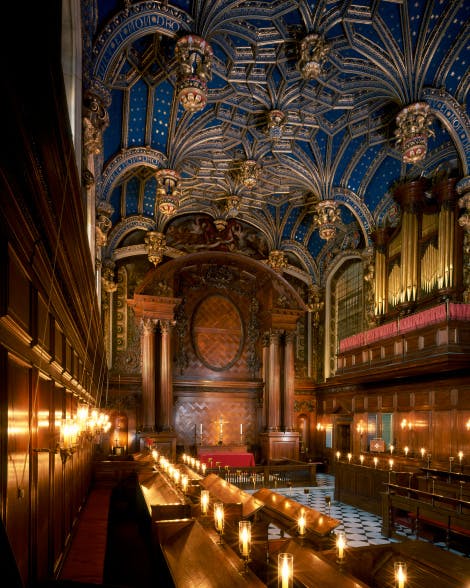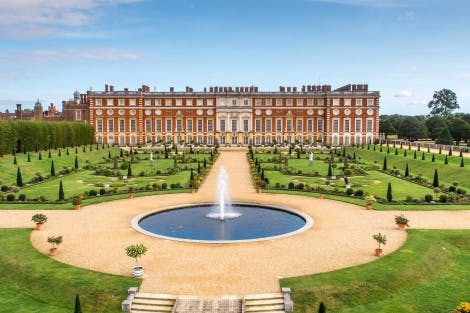
A forgotten story
In late July 1919 one of the most extraordinary but forgotten visits to Hampton Court Palace took place. A contingent of nearly 1,800 troops from the Indian Army, including their British and Indian officers, marched through the palace gates and onto Home Park, where they camped for the next two months.
They returned to a shattered Europe by ship from Mumbai (then known as Bombay) months after the armistice that ended the First World War. Here, they joined the national Peace Celebrations with soldiers from around the British Empire, who had fought alongside each other.
The Indian Army troops were representatives of the more than 500,000 who fought in the war, from the Western Front in France and Belgium, to the Middle East and Far East.
When the First World War broke out in 1914, there was a reluctance by the British to allow Indian soldiers to fight alongside white troops. This was soon abandoned, as the relatively small British Army and its allies struggled against overwhelming German forces.
Header image: Indian troops marching from their camp in Home Park through the Palace gardens, August 1919. © Collection of John Sheaf
The Indian Expeditionary Force arrived in the nick of time.
Lord Curzon, former Viceroy of India, 1917.
Do not think this is war. This is not war. It is the ending of the world. This is just such a war as was related in the Mahabharata about our forefathers.
A wounded Punjabi Rajput to a relative in India, 29 January 1915. From a translation in Indian Voices of the Great War/Soldiers Letters, 1914-18 by David Omissi, reproduced with kind permission.
The peace contingent made up probably the largest movement of people from the Indian subcontinent to Britain at the time - certainly from rural India - and made a great impression on the nation, which was captured in the press and even early news reels.
[This video has no sound]
This content is hosted on YouTube
This content may be using cookies and other technologies for which we need your consent before loading. To view the content, you need to enable cookies for "Targeting Cookies & Other Technologies".
Manage CookiesVarious shots troops parading under Admiralty Arch, some regiments white (wearing tropics uniforms) but most are Asian. Various shots Indian soldiers marching about field - probably grounds to Buckingham Palace. Indian and British soldiers on steps of Buckingham Palace. More shots parade, ambulances and crowds follow at end of parade. Parade passes Cenotaph, some soldiers hold up banners with places where they have served - e.g. Palestine and France. King George V and Queen Mary present medals to Indian officers on steps of Buckingham Palace, Indian and English dignitaries watch. Pan over soldiers standing to attention in grounds of Palace. CU Gurkha. More shots medal presentation (out of focus). Troops give three cheers. King takes salute at march past by Indian troops. More shots parade: troops going into Buckingham Palace, passing Victoria Memorial. Panning shot Indian women sitting on curb watching parade pass. Parade going down the Mall. Soldiers parading in grounds of Palace. General shots parade. VS soldiers milling about grounds of palace at Royal garden party. Nice shots Sikh soldiers looking at each other's medals, in other shots we see Gurkhas sitting on ground smoking cigarettes.
The plan had been for the contingent to join the Victory Parade on 19 July, but when the Peace Treaty of Versailles was finally signed during their voyage, it was obvious they would not arrive in time. When influenza broke out on board ship, leaving five men dead, their journey seemed fruitless. However, King George V led calls for the troops to have their own parade on 2 August.
On a blazing summer day they marched past the new Cenotaph memorial in Whitehall. They carried banners with the names of the places across the globe where they had fought.
Crowds turned out to cheer, women threw flowers and bands of Guards played at the head of their parade. The march ended with a review by the King and a garden party at Buckingham Palace. Here, 19-year-old Gurkha Naik Karanbahadur Rana was presented with his Victoria Cross.

Image: A Sikh regiment from the Indian Contingent parading up the Mall towards Buckingham Palace, Victory Parade August 2nd 1919. © Historic Royal Palaces
I heartily thank all my Indian Soldiers for their loyal devotion to me and to my Empire, and for their sufferings cheerfully borne in the various campaigns in which they have served in lands and climates so very different from their own.
From King George V's speech on 2nd August 1919

Image: Indian troops saluting the Cenotaph on their Victory Parade in Whitehall, London 1919. © Historic Royal Palaces
For over six weeks, the soldiers were well looked-after and entertained on tours of London and across Britain. Their hosts impressed them with the sights and also the military might of the 'home nation'.
They toured in red London buses - the same buses that had driven some of them to the Western Front in 1914. They visited the Tower of London, Madame Tussaud's and a Chelsea football match.
There were trips to a secret warship at Portsmouth dockyard, a bombing demonstration on the River Medway in Kent, and flights at the Handley-Page aircraft factory. They even took a trip down the River Clyde from Glasgow.
Read more: The Tower of London and the First World War
The camp was laid out along the River Thames, with streets separating the British and Indian officers’ bell tents from the other ranks. This was not the first time Indian soldiers had camped at Hampton Court; the army fell back on plans made for the coronation celebrations of Edward VII and George V in 1902 and 1910.
Careful arrangements were made to respect the religious and social customs of the different peoples represented by regiments from across India and its modern neighbours – including Sikhs, Muslims and Hindus. There were separate slaughter pens and kitchens, laundries and latrines (dug toilets) run by civilian camp ‘followers’. Entertainments were laid on including a cinema tent provided by the Young Men’s Christian Association as well as organised sports, and the men were allowed to leave camp with a pass.

Image: Indian soldiers playing football in the camp on the golf course at Home Park, Hampton Court, autumn 1919 (from Our Indian Army illustrated by W. Luker Jr). Royal Collection Trust / © Her Majesty Queen Elizabeth II 2021

Image: A barber shaving a soldier in the 1902 Coronation camp at Hampton Court. © Historic Royal Palaces.
Behind this forgotten story of British and Indian comradeship in victory hides a much more complicated one of India's role in the First World War. The Indian Army was the creation of British colonial rule, built around racial prejudices to secure dominion over the Indian subcontinent. The Peace Celebrations of 1919 brought this great contribution and sacrifice to the public’s attention but as promises of greater self-rule dwindled, this story from the First World War became easier to forget.
Further Reading
- The Indian Empire at War by George Morton-Jack (2018)
- The World’s War: Forgotten Soldiers of Empire by David Olusoga (2014)
- Indian Voices of the Great War/Soldiers Letters, 1914-18 by David Omissi (1999, 2014)
- Thousands of Heroes Have Arisen: Sikh Voices of the Great War 1914-1918, by Sukwinder Singh Bassi (2019)
Learn more on your visit

The Indian Army at the Palace
Until 01 February 2026
Explore the forgotten story of Indian Army soldiers who camped at Hampton Court Palace in the early 20th century, through a new display of previously unseen objects, photographs, film and personal stories.
Browse more history and stories

Sophia Duleep Singh
The Indian Princess who fought for women's rights

The Tower of London and the First World War
The Tower of London played an important role in the First World War

The story of Hampton Court Palace
Home of Henry VIII and the Tudor dynasty
Explore what's on

- Exhibition
- Things to see
The Indian Army at the Palace
Explore the forgotten story of Indian Army soldiers who camped at Hampton Court Palace in the early 20th century, through a new exhibition of previously unseen objects, photographs, film and personal stories.
-
Until 01 February 2026 (closes on 01 February)
- In line with palace opening hours
- Hampton Court Palace
- Included in palace admission (Members go free)

- Events
- Families
Rise and Roar
Quiet sessions in The Magic Garden, aimed at Neurodivergent and Learning-Disabled children, and their families and friends.
-
TBC
- 09:30 - 11:00
- Hampton Court Palace
- Included in palace admission (Members go free)

- Things to see
Hampton Court Gardens
Take time to explore and relax in these world-renowned gardens and find our free entry Garden Open Days dates.
- Open
- In line with palace opening hours
- Hampton Court Palace
- Included in palace admission (Members go free)
